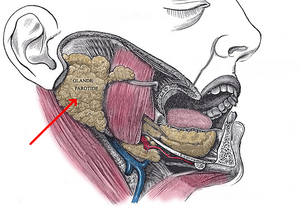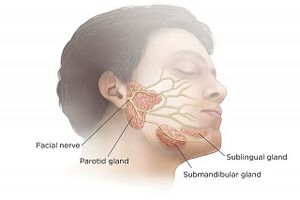Parotid Gland
Introduction[edit | edit source]
The parotid gland is the largest of three paired major salivary glands. The salivary glands' primary function is to secrete saliva, which plays an important role in lubrication, digestion, immunity, and the overall maintenance of homeostasis within the human body.[1]
Anatomy[edit | edit source]
The paired parotid glands are situated in the preauricular region and span from the masseter to the posterior surface of the mandible. It is within the submandibular/digastric triangle of the neck.
The gland is divided into superficial and deep lobes by the facial nerve: [1]
- Superficial lobe - the part of the gland lateral to the nerve and overlies the lateral surface of the masseter muscle.
- Deep lobe - located medial to the facial nerve and lies between the mastoid process of the temporal bone and the mandibular ramus with deep margins resting in the prestyloid compartment of the parapharyngeal space.
Physiology[edit | edit source]
Vascular Supply & Lymphatic Drainage[edit | edit source]
Vascular supply of parotid gland:[1]
- Arterial blood supply: External carotid artery
- Venous outflow: retromandibular vein, which is formed by the maxillary and superficial temporal veins.
There is a high density of lymph nodes within and around the parotid gland. The parotid is the only salivary gland with 2 nodal layers, both drains into the superficial and deep cervical lymph systems. [1]
Autonomic Innervation[edit | edit source]
The glossopharyngeal nerve (CN IX) provides innervation required for secretion of saliva to the parotid gland.CN IX carries preganglionic parasympathetic fibers from the medulla (inferior salivatory nucleus) through the jugular foramen.[1]








